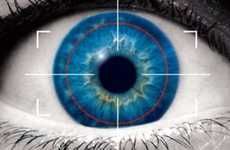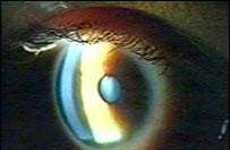
Canon Iris Registration Watermark
References: photographybay & ohgizmo
Any photographer knows how frustrating it is to have their images used without their permission. A new innovation, however, would allow for photo copyrighting to be all in the eye. Don't see what I mean?
Two protection techniques used before are watermarking and severe compression, yet those ruin the overall appearance of the image, making it hard to assess its detailed attributes. A new concept, for which Canon is trying to get the patent for, actually uses the ultra unique pattern of the eye's iris to protect the image.
When a photographer looks through the lens (point and shoot digitals don't work in this case) of the camera, a tiny secondary camera within captures the details of the photographer's iris, the coloured portion of the eye with patterns just as unique as a fingerprint.
This would be activated when the Canon is put into "REG" mode, so could be shut off if the photographer chooses.
The information would be stored along with the rest of the photo details (such as ISO setting, aperture value, etc.) and added to the image's metadata.
Two protection techniques used before are watermarking and severe compression, yet those ruin the overall appearance of the image, making it hard to assess its detailed attributes. A new concept, for which Canon is trying to get the patent for, actually uses the ultra unique pattern of the eye's iris to protect the image.
When a photographer looks through the lens (point and shoot digitals don't work in this case) of the camera, a tiny secondary camera within captures the details of the photographer's iris, the coloured portion of the eye with patterns just as unique as a fingerprint.
This would be activated when the Canon is put into "REG" mode, so could be shut off if the photographer chooses.
The information would be stored along with the rest of the photo details (such as ISO setting, aperture value, etc.) and added to the image's metadata.
Trend Themes
1. Eye-based Digital Watermarking - Using the unique patterns of the eye's iris for digital watermarking provides a non-intrusive and secure method for copyright protection.
2. Enhanced Copyright Protection - Integrating iris registration watermarking with image metadata offers an effective solution to prevent unauthorized image usage.
3. Non-destructive Image Protection - Replacing traditional watermarking and compression techniques with iris-based watermarking allows for image protection without compromising visual quality.
Industry Implications
1. Photography - The photography industry can leverage eye-based digital watermarking technology to safeguard photographer's copyrights and prevent unauthorized image use.
2. Intellectual Property Rights - Eye-based digital watermarking presents innovative opportunities in the intellectual property rights industry to enhance copyright protection for creative works.
3. Technology and Security - The integration of iris registration watermarking into image metadata opens up disruptive innovation opportunities in the technology and security sectors for enhancing data protection.
2.8
Score
Popularity
Activity
Freshness























